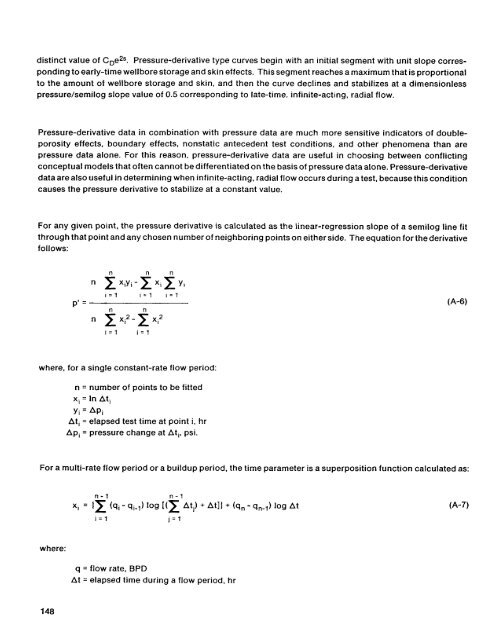Beauheim 1987 - Waste Isolation Pilot Plant - U.S. Department of ...
Beauheim 1987 - Waste Isolation Pilot Plant - U.S. Department of ...
Beauheim 1987 - Waste Isolation Pilot Plant - U.S. Department of ...
You also want an ePaper? Increase the reach of your titles
YUMPU automatically turns print PDFs into web optimized ePapers that Google loves.
distinct value <strong>of</strong> Coe2s. Pressure-derivative type curves begin with an initial segment with unit slope corresponding<br />
to early-time wellbore storage and skin effects. This segment reaches a maximum that is proportional<br />
to the amount <strong>of</strong> wellbore storage and skin, and then the curve declines and stabilizes at a dimensionless<br />
pressure/semilog slope value <strong>of</strong> 0.5 corresponding to late-time, infinite-acting, radial flow.<br />
Pressure-derivative data in combination with pressure data are much more sensitive indicators <strong>of</strong> doubleporosity<br />
effects, boundary effects. nonstatic antecedent test conditions, and other phenomena than are<br />
pressure data alone. For this reason, pressure-derivative data are useful in choosing between conflicting<br />
conceptual models that <strong>of</strong>ten cannot be differentiated on the basis <strong>of</strong> pressure data alone. Pressure-derivative<br />
data are also useful in determining when infinite-acting, radial flow occurs during a test, because this condition<br />
causes the pressure derivative to stabilize at a constant value.<br />
For any given point, the pressure derivative is calculated as the linear-regression slope <strong>of</strong> a semilog line fit<br />
through that point and any chosen number <strong>of</strong> neighboring points on either side. Theequation for the derivative<br />
follows:<br />
p' =<br />
i=l i=l 1=1<br />
n<br />
n<br />
(A-6)<br />
i=l<br />
i=l<br />
where, for a single constant-rate flow period:<br />
n = number <strong>of</strong> points to be fitted<br />
xi = In At,<br />
Yi = APi<br />
Ati = elapsed test time at point i, hr<br />
Ap, = pressure change at Ati. psi.<br />
For a multi-rate flow period or a buildup period, the time parameter is a superposition function calculated as:<br />
n-1 n-1<br />
i=l<br />
j=l<br />
(A-7)<br />
where:<br />
q = flow rate, BPD<br />
At = elapsed time during a flow period, hr<br />
148

















